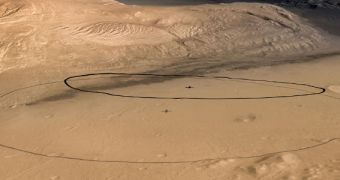Even though the Mars Science Laboratory (MSL) rover Curiosity is heading towards the slopes of Mount Sharp, at the core of Gale Crater, scientists still know very little about the nature of this mountain. What is clear at this point is that the structure was produced by an asteroid collision.
The ancient impact was so powerful that the ejected plumes of materials then settled into a 3-mile (5-kilometer) tall mountain. Given that the material mixed during the catastrophic collision, experts hope to see tremendous rock diversity at this location, Space reports.
Mount Sharp's layered slopes may hold the key towards understanding the environmental and climate conditions that existed on the surface of Mars more than a billion years ago. Data obtained in this manner could finally reveal if the Red Planet was ever capable of supporting microbial life.
Interestingly, the low-inclination slopes of the mountain may grant Curiosity access all the way to the top, if its nuclear power source can handle the strain. However, the climb will take several years.

 14 DAY TRIAL //
14 DAY TRIAL //